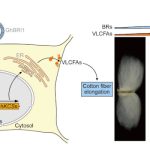Plant Science Research Weekly: August 18, 2023
Review: Strigolactones integrate metabolic and nutritional signals
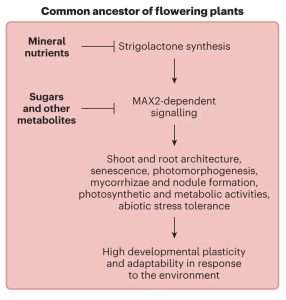 Strigolactones are a class of hormones first identified in the 1960s as components of root exudates that promote germination of parasitic Striga seeds, and later as a promoter of associations with arbuscular mycorrhizal fungi. Strigolactones also have endogenous roles within plants, for example as regulators of shoot branching. More recently, they have been shown to be involved in metabolic and nutrient sensing and signaling. These latter roles are summarized in a new review by Barbier et al. Several studies have demonstrated that the synthesis of strigolactones is stimulated by nutrient deficiency. Interestingly, changes in sugar metabolites affect strigolactone signaling but not apparently its synthesis. The molecular interactions through which these effects are mediated are also discussed. Finally, the authors discuss the many ways through which strigolactones help plants adapt to unfavorable environmental conditions. (Summary by Mary Williams @PlantTeaching) Nature Plants 10.1038/s41477-023-01453-6
Strigolactones are a class of hormones first identified in the 1960s as components of root exudates that promote germination of parasitic Striga seeds, and later as a promoter of associations with arbuscular mycorrhizal fungi. Strigolactones also have endogenous roles within plants, for example as regulators of shoot branching. More recently, they have been shown to be involved in metabolic and nutrient sensing and signaling. These latter roles are summarized in a new review by Barbier et al. Several studies have demonstrated that the synthesis of strigolactones is stimulated by nutrient deficiency. Interestingly, changes in sugar metabolites affect strigolactone signaling but not apparently its synthesis. The molecular interactions through which these effects are mediated are also discussed. Finally, the authors discuss the many ways through which strigolactones help plants adapt to unfavorable environmental conditions. (Summary by Mary Williams @PlantTeaching) Nature Plants 10.1038/s41477-023-01453-6
Evolution of cytosolic and organellar invertases empowered the colonization and thriving of land plants
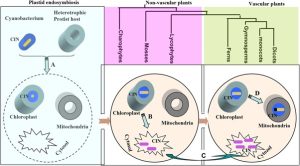 Invertases catalyse the conversion of sucrose into glucose and fructose. In plants, invertases fall into two clades – the mitochondrially/plastid localized α clade and the cytoplasmically localized β clade. However, we do not fully understand how these clades evolved. Here Wan et al. identified 665 invertases from 77 species across the plant kingdom. Phylogenetic analysis showed that invertases first appeared in charophyte algae due to endosymbiotic gene transfer from a cyanobacterium. The α1 clade, a plastid localised subgroup of the α clade, are the most basal invertases. Examination of N-terminal sequences revealed that α1 invertases are approximately 100 bp longer than β clade invertases. Combining this with phylogenetic analysis revealed that the β clade arose from duplication and subsequent loss of the transit peptide of the α1 clade. This happened before land plants diverged from charophyte algae. The α1 clade underwent an additional duplication event as vascular plants emerged, which led to the generation of the mitochondrially localised α2 clade. Collectively these results shed light on invertase evolution, and the authors suggest this was important for allowing plants to colonize land. (Summary by Rose McNelly @Rose_McN) Plant Physiol. 10.1093/plphys/kiad401
Invertases catalyse the conversion of sucrose into glucose and fructose. In plants, invertases fall into two clades – the mitochondrially/plastid localized α clade and the cytoplasmically localized β clade. However, we do not fully understand how these clades evolved. Here Wan et al. identified 665 invertases from 77 species across the plant kingdom. Phylogenetic analysis showed that invertases first appeared in charophyte algae due to endosymbiotic gene transfer from a cyanobacterium. The α1 clade, a plastid localised subgroup of the α clade, are the most basal invertases. Examination of N-terminal sequences revealed that α1 invertases are approximately 100 bp longer than β clade invertases. Combining this with phylogenetic analysis revealed that the β clade arose from duplication and subsequent loss of the transit peptide of the α1 clade. This happened before land plants diverged from charophyte algae. The α1 clade underwent an additional duplication event as vascular plants emerged, which led to the generation of the mitochondrially localised α2 clade. Collectively these results shed light on invertase evolution, and the authors suggest this was important for allowing plants to colonize land. (Summary by Rose McNelly @Rose_McN) Plant Physiol. 10.1093/plphys/kiad401
CPK32 regulates cellulose biosynthesis through post-translational modification of cellulose synthase
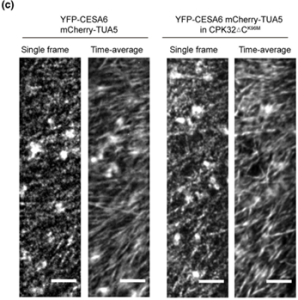 Cellulose in one of the most abundant polymers on the planet and is synthesized by plasma membrane-bound cellulose synthases (CESAs). Phosphorylation plays a role in CESA regulation, however the kinases which catalyse the phosphorylation are not well described. Here Xin et al. identified calcium-dependent protein kinase 32 (CPK32) as an interactor of CESA3 in a yeast two hybrid screen. In vitro kinase assays revealed that CPK32 phosphorylates the catalytic domain of CESA3. To investigate how CPK32 phosphorylation affects CESA activity, they mutated a lysine residue in the CPK32 ATP-binding site (CPK32ΔCK96M). This mutation prevented kinase activity but not the interaction with CESAs. When CPK32ΔCK96M was transformed into Arabidopsis thaliana plants expressing YFP-tagged CESAs, CESA-YFP movement decreased by 28%. There was also a decrease in CESA-YFP stability. Protein degradation experiments showed a 30% reduction in the amount of CESA-YFP when CPK32ΔCK96M was expressed. This suggests a novel role of phosphorylation in controlling CESA stability during cellulose biosynthesis. (Summary by Rose McNelly @Rose_McN) New Phytol. 10.1111/nph.19106
Cellulose in one of the most abundant polymers on the planet and is synthesized by plasma membrane-bound cellulose synthases (CESAs). Phosphorylation plays a role in CESA regulation, however the kinases which catalyse the phosphorylation are not well described. Here Xin et al. identified calcium-dependent protein kinase 32 (CPK32) as an interactor of CESA3 in a yeast two hybrid screen. In vitro kinase assays revealed that CPK32 phosphorylates the catalytic domain of CESA3. To investigate how CPK32 phosphorylation affects CESA activity, they mutated a lysine residue in the CPK32 ATP-binding site (CPK32ΔCK96M). This mutation prevented kinase activity but not the interaction with CESAs. When CPK32ΔCK96M was transformed into Arabidopsis thaliana plants expressing YFP-tagged CESAs, CESA-YFP movement decreased by 28%. There was also a decrease in CESA-YFP stability. Protein degradation experiments showed a 30% reduction in the amount of CESA-YFP when CPK32ΔCK96M was expressed. This suggests a novel role of phosphorylation in controlling CESA stability during cellulose biosynthesis. (Summary by Rose McNelly @Rose_McN) New Phytol. 10.1111/nph.19106
Cell polarity linked to gravity sensing is generated by LZY translocation from statoliths to the plasma membrane
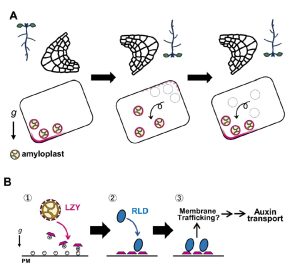 In plants, gravity sensing is orchestrated by specialized cells called statocytes that contain starch-filled plastids (amyloplasts) called statoliths, whose positions are influenced by the direction of gravity. However, the molecular mechanisms of gravity sensing and signaling are poorly understood. In Arabidopsis, LAZY1-LIKE (LZY) family genes have been shown to be required for auxin redistribution in response to gravitropic stimulation. Nishimura et al. investigated the role of LZY3 polarization in gravity sensing and gravitropism. The LZY3 protein, despite lacking a detectable transmembrane domain, appears to have basic hydrophobic clusters that can help with membrane association. The authors introduced glutamine substitutions into two sites to decrease the basic hydrophobic cluster. Altering the basic hydrophobic cluster at site A led to an accumulation of LZY3 in the basal region of the plasma membrane (PM), rescuing the primary root angle in the lzy2;3;4 triple mutant and demonstrating a role for membrane association in LZY3 function. The authors also showed that establishment of LZY polarity on the PM occurs by translocation of LZY from amyloplasts to the PM. All these together show the role of LZY as a signal molecule responsible for conveying the positional information of statoliths to the PM, which directly links gravity sensing to downstream signaling. (Summary by Andrea Gómez-Felipe @andreagomezfe) Science 10.1126/science.adh9978
In plants, gravity sensing is orchestrated by specialized cells called statocytes that contain starch-filled plastids (amyloplasts) called statoliths, whose positions are influenced by the direction of gravity. However, the molecular mechanisms of gravity sensing and signaling are poorly understood. In Arabidopsis, LAZY1-LIKE (LZY) family genes have been shown to be required for auxin redistribution in response to gravitropic stimulation. Nishimura et al. investigated the role of LZY3 polarization in gravity sensing and gravitropism. The LZY3 protein, despite lacking a detectable transmembrane domain, appears to have basic hydrophobic clusters that can help with membrane association. The authors introduced glutamine substitutions into two sites to decrease the basic hydrophobic cluster. Altering the basic hydrophobic cluster at site A led to an accumulation of LZY3 in the basal region of the plasma membrane (PM), rescuing the primary root angle in the lzy2;3;4 triple mutant and demonstrating a role for membrane association in LZY3 function. The authors also showed that establishment of LZY polarity on the PM occurs by translocation of LZY from amyloplasts to the PM. All these together show the role of LZY as a signal molecule responsible for conveying the positional information of statoliths to the PM, which directly links gravity sensing to downstream signaling. (Summary by Andrea Gómez-Felipe @andreagomezfe) Science 10.1126/science.adh9978
Membrane lipid phosphoinositides signature the final step of plant cytokinesis
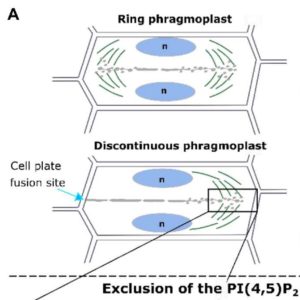 Phosphoinositides (membrane lipids with cytosolic inositol headgroups carrying phosphate residues at various positions) serve as road markings for membrane and membrane/cytoskeleton dynamics. Here, Lebeco et al. add further detail to the map. Previously the authors showed that the plant-specific enzyme phosphoinositide phosphatase SAC9 participates in the restriction of phosphatidylinositol 4,5-bisphosphate [PI(4,5)P2] at the plasma membrane during endocytosis. In this study, they demonstrate a novel role for PI(4,5)P2 in the final stage of cytokinesis, when the cell plate connects with the maternal membrane. As the cell plate is expanding towards the maternal membranes at the edge of the dividing cell, SAC9 protein is enriched at the leading edge and its substrate PI(4,5)P2 is depleted. When the phragmoplast attaches, SAC9 protein is dissipated. In loss-of-function sac9 mutants, PI(4,5)P2 is present at the leading edge of the phragmoplast and branching occurs from the phragmoplast. The authors propose that the presence of PI(4,5)P2 at the phragmoplast leading edge leads to to ectopic recruitment of the cytokinesis apparatus and formation of an additional cell plate insertion site. (Summary by Mary Williams @PlantTeaching) Sci. Adv. 10.1126/sciadv.adf7532
Phosphoinositides (membrane lipids with cytosolic inositol headgroups carrying phosphate residues at various positions) serve as road markings for membrane and membrane/cytoskeleton dynamics. Here, Lebeco et al. add further detail to the map. Previously the authors showed that the plant-specific enzyme phosphoinositide phosphatase SAC9 participates in the restriction of phosphatidylinositol 4,5-bisphosphate [PI(4,5)P2] at the plasma membrane during endocytosis. In this study, they demonstrate a novel role for PI(4,5)P2 in the final stage of cytokinesis, when the cell plate connects with the maternal membrane. As the cell plate is expanding towards the maternal membranes at the edge of the dividing cell, SAC9 protein is enriched at the leading edge and its substrate PI(4,5)P2 is depleted. When the phragmoplast attaches, SAC9 protein is dissipated. In loss-of-function sac9 mutants, PI(4,5)P2 is present at the leading edge of the phragmoplast and branching occurs from the phragmoplast. The authors propose that the presence of PI(4,5)P2 at the phragmoplast leading edge leads to to ectopic recruitment of the cytokinesis apparatus and formation of an additional cell plate insertion site. (Summary by Mary Williams @PlantTeaching) Sci. Adv. 10.1126/sciadv.adf7532
Jurassic ZAR; Insights from an atypically conserved immune receptor
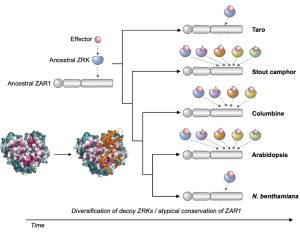 It’s a well-established fact that some proteins are highly variable across species, and others such as histones hardly vary at all. Highly conserved proteins such as histones have very little wiggle room in their structure; small changes can lead to a loss of function. However, for some other proteins variation in sequence and structure is evolutionarily advantageous; proteins that detect pathogens, such as antibodies in humans, are highly variable in order to recognize the huge range of pathogen signatures that might be encountered. Similarly, in plants, there is a high amount of sequence variation in immune receptor proteins, with one notable exception being ZAR1. In this new study, Adachi et al. reconstructed the evolutionary history of this atypically conserved protein. Previously, cryo-EM structural studies of ZAR1 in association with its partner, receptor-like cytoplasmic kinase (RLCK), revealed a resistome complex and key functional domains. In this work, the authors looked at 120 ZAR1 orthologue sequences from 88 species, revealing its highly conserved and more recent features. The authors conclude that, atypically, this protein has changed little since its origins during the Jurassic period. (Interesting aside: the article states the work was initiated during the COVID-19 lockdown, and thanks the Prime Minister of the UK for announcing a stay-at-home order in March 2020; perhaps the first time a Prime Minister has been acknowledged in The Plant Cell?) (Summary by Mary Williams @PlantTeaching) Plant Cell 10.1093/plcell/koad175
It’s a well-established fact that some proteins are highly variable across species, and others such as histones hardly vary at all. Highly conserved proteins such as histones have very little wiggle room in their structure; small changes can lead to a loss of function. However, for some other proteins variation in sequence and structure is evolutionarily advantageous; proteins that detect pathogens, such as antibodies in humans, are highly variable in order to recognize the huge range of pathogen signatures that might be encountered. Similarly, in plants, there is a high amount of sequence variation in immune receptor proteins, with one notable exception being ZAR1. In this new study, Adachi et al. reconstructed the evolutionary history of this atypically conserved protein. Previously, cryo-EM structural studies of ZAR1 in association with its partner, receptor-like cytoplasmic kinase (RLCK), revealed a resistome complex and key functional domains. In this work, the authors looked at 120 ZAR1 orthologue sequences from 88 species, revealing its highly conserved and more recent features. The authors conclude that, atypically, this protein has changed little since its origins during the Jurassic period. (Interesting aside: the article states the work was initiated during the COVID-19 lockdown, and thanks the Prime Minister of the UK for announcing a stay-at-home order in March 2020; perhaps the first time a Prime Minister has been acknowledged in The Plant Cell?) (Summary by Mary Williams @PlantTeaching) Plant Cell 10.1093/plcell/koad175
Adaptive evolution of the enigmatic Takakia moss now facing climate change in Tibet
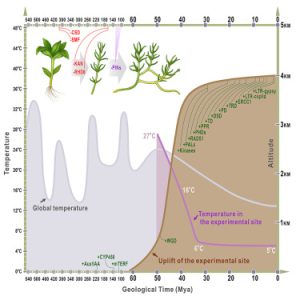 In this fantastic, engaging paper, Hu et al. carries the reader from the origins of life on land through the dramatic uplift of the Tibetan plateau and into the modern age of climate change, all through the lens of the “enigmatic” Takakia moss. It’s enigmatic because it has features that are more similar to liverworts, and in fact it’s now considered a sister clade to other mosses. Analysis of its biochemistry, cell biology, morphology, and genome reveal its early adaptations to life on land were followed by later adaptations including tolerance to severe UV radiation as it was thrust upwards when the Himalayans were formed by the India-Asian collision. These adaptations arose from fast-evolving genes involved in DNA repair and response to reactive oxygen damage, among others. But what makes this story so compelling is the most recent chapter. The authors discovered this species in 2005 and have since charted its steep decline in population in response to a very rapid increase in temperature (at the field site, the temperature rise over the past decade is the highest increase in recorded history). It seems that this tough little survivor may have met its match in anthropogenic climate change. (Summary by Mary Williams @PlantTeaching) Cell 10.1016/j.cell.2023.07.003
In this fantastic, engaging paper, Hu et al. carries the reader from the origins of life on land through the dramatic uplift of the Tibetan plateau and into the modern age of climate change, all through the lens of the “enigmatic” Takakia moss. It’s enigmatic because it has features that are more similar to liverworts, and in fact it’s now considered a sister clade to other mosses. Analysis of its biochemistry, cell biology, morphology, and genome reveal its early adaptations to life on land were followed by later adaptations including tolerance to severe UV radiation as it was thrust upwards when the Himalayans were formed by the India-Asian collision. These adaptations arose from fast-evolving genes involved in DNA repair and response to reactive oxygen damage, among others. But what makes this story so compelling is the most recent chapter. The authors discovered this species in 2005 and have since charted its steep decline in population in response to a very rapid increase in temperature (at the field site, the temperature rise over the past decade is the highest increase in recorded history). It seems that this tough little survivor may have met its match in anthropogenic climate change. (Summary by Mary Williams @PlantTeaching) Cell 10.1016/j.cell.2023.07.003
The impact of climate change on endangered plants and lichen
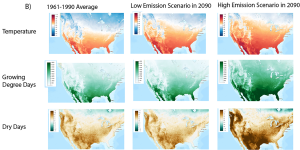 As global CO2 emissions continue to rise, wildlife faces new challenges due to climate change. The biotic and environmental factors impacted by the rising temperature and sea level pose unprecedented threat to the plants and lichens listed on the Endangered Species Act (ESA). In this paper, the tolerance of plants to climate change was reevaluated on 771 ESA-listed plants by a trait-based assessment, providing updated information about the urgency of taking action for the recovery of threatened species. The authors used nine sensitivity factors, Temperature, Hydrology, Disturbance, Isolation, Injurious species, Chemistry, Phenology, Obligate relationships, and Humidity to quantify the sensitivity of endangered plants to climate change. The most prevalent sensitivity factors across all regions are disturbance and injurious species, especially for species that lack mobility. All of the assessed species are sensitive to at least one factor, and the sensitivity varies across the eight US Fish and Wildlife Service (FWS) regions. Among these species, 89% of plants are found to be threatened by climate change, but only 3.6% have direct actions in place to counteract the impacts. Some conservation actions, including long-term monitoring on targeted species and seed banking to save reproduction materials have been initiated to combat climate change threats. As the climatic conditions persistently evolve, the promotion and expansion of such actions become more and more crucial for species recovery. (Summary by Diwen Wang @Diwen_w) PLOS Climate 10.1371/journal.pclm.0000225
As global CO2 emissions continue to rise, wildlife faces new challenges due to climate change. The biotic and environmental factors impacted by the rising temperature and sea level pose unprecedented threat to the plants and lichens listed on the Endangered Species Act (ESA). In this paper, the tolerance of plants to climate change was reevaluated on 771 ESA-listed plants by a trait-based assessment, providing updated information about the urgency of taking action for the recovery of threatened species. The authors used nine sensitivity factors, Temperature, Hydrology, Disturbance, Isolation, Injurious species, Chemistry, Phenology, Obligate relationships, and Humidity to quantify the sensitivity of endangered plants to climate change. The most prevalent sensitivity factors across all regions are disturbance and injurious species, especially for species that lack mobility. All of the assessed species are sensitive to at least one factor, and the sensitivity varies across the eight US Fish and Wildlife Service (FWS) regions. Among these species, 89% of plants are found to be threatened by climate change, but only 3.6% have direct actions in place to counteract the impacts. Some conservation actions, including long-term monitoring on targeted species and seed banking to save reproduction materials have been initiated to combat climate change threats. As the climatic conditions persistently evolve, the promotion and expansion of such actions become more and more crucial for species recovery. (Summary by Diwen Wang @Diwen_w) PLOS Climate 10.1371/journal.pclm.0000225
Insights from a survey of mentorship experiences
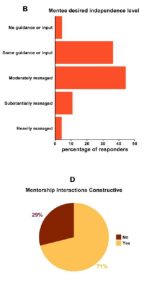 What do mentees want and need from their mentors, and are they getting it? How do factors such as gender identity and internationalism affect the quality of mentor/mentee interactions? Results from a survey of more than 2000 mentees (mostly postdocs and graduate students) are reported, along with a thorough analysis and concrete recommendations. The typical situation in most laboratories that biologists train in involves a single mentor (the principal investigator, PI) as the nearly sole point of support for graduate students and postdocs. Sadly, most PIs have had minimal training in effective mentorship, as illustrated by the results of this survey. In addition to reporting a great deal of data, this article also provides an excellent set of recommendations to improve the mentoring relationship, and to avoid common pitfalls. (Summary by Mary Williams @PlantTeaching) bioRxiv https://www.biorxiv.org/content/10.1101/2023.05.05.539640v1
What do mentees want and need from their mentors, and are they getting it? How do factors such as gender identity and internationalism affect the quality of mentor/mentee interactions? Results from a survey of more than 2000 mentees (mostly postdocs and graduate students) are reported, along with a thorough analysis and concrete recommendations. The typical situation in most laboratories that biologists train in involves a single mentor (the principal investigator, PI) as the nearly sole point of support for graduate students and postdocs. Sadly, most PIs have had minimal training in effective mentorship, as illustrated by the results of this survey. In addition to reporting a great deal of data, this article also provides an excellent set of recommendations to improve the mentoring relationship, and to avoid common pitfalls. (Summary by Mary Williams @PlantTeaching) bioRxiv https://www.biorxiv.org/content/10.1101/2023.05.05.539640v1
Additional time demands on non-native English speakers
 As a monolinguist, I’m in awe of people who can write papers and speak at conferences in a language other than their first, but I never thought to quantify the additional burden that’s place on non-native English speakers. Fortunately, Amano and colleagues decided to ask this question, and the results are sobering if not surprising; overall, non-native English speakers spend significantly more time reading and writing papers, face more rejections due to language issues, and are less likely to attend or give a talk at an English-language-based conference. The article concludes with several recommendations for how these extra burdens can be alleviated, with roles spanning from supervisors to funders to publishers and conference organizers. (Summary by Mary Williams @PlantTeaching) PLOS Biol 10.1371/journal.pbio.3002184
As a monolinguist, I’m in awe of people who can write papers and speak at conferences in a language other than their first, but I never thought to quantify the additional burden that’s place on non-native English speakers. Fortunately, Amano and colleagues decided to ask this question, and the results are sobering if not surprising; overall, non-native English speakers spend significantly more time reading and writing papers, face more rejections due to language issues, and are less likely to attend or give a talk at an English-language-based conference. The article concludes with several recommendations for how these extra burdens can be alleviated, with roles spanning from supervisors to funders to publishers and conference organizers. (Summary by Mary Williams @PlantTeaching) PLOS Biol 10.1371/journal.pbio.3002184


